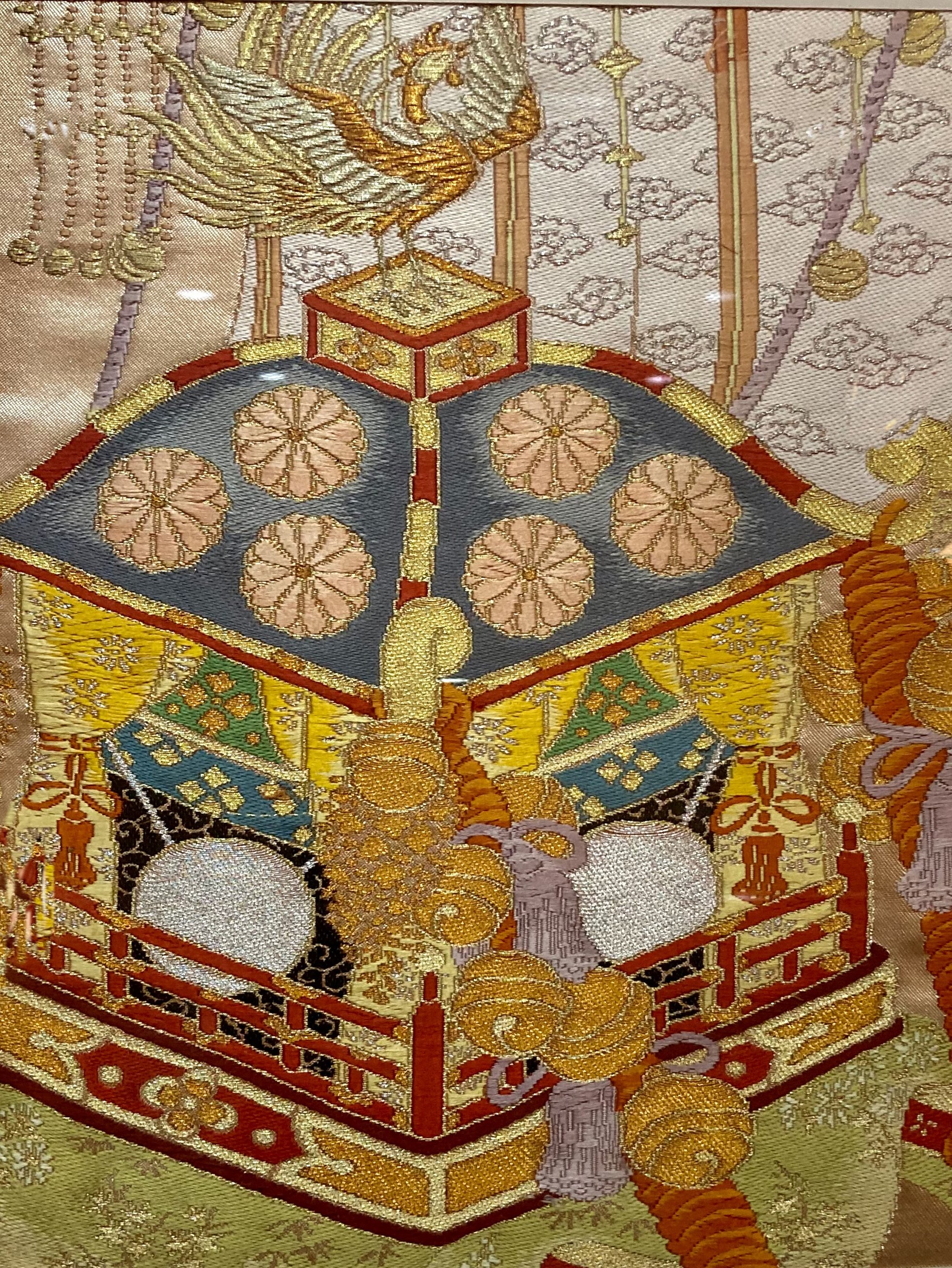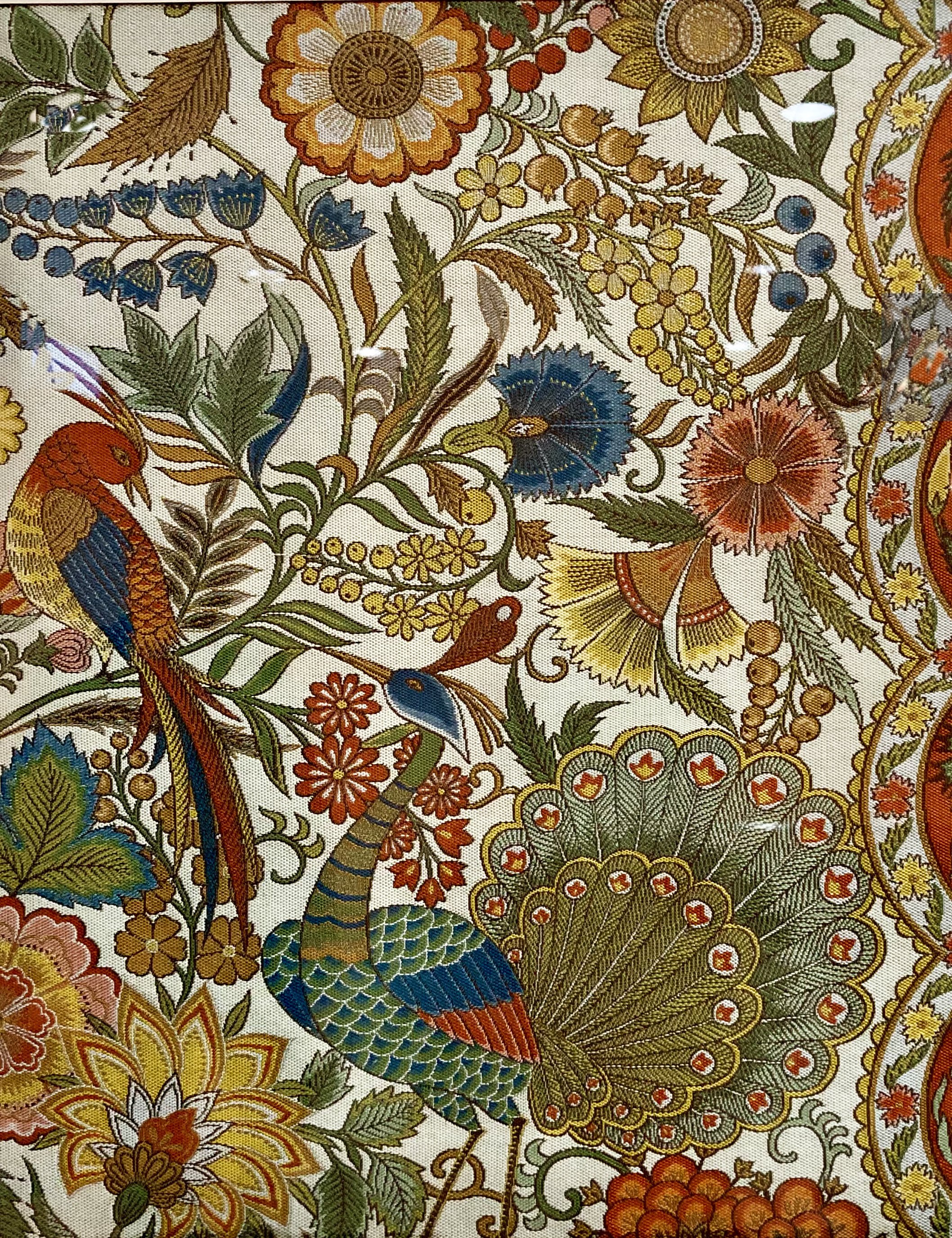Ideally, serendipity should always play a part in travels. Thanks to a wonderfully diligent friend’s careful guidebook reading of places to visit in Kyoto, Japan, we headed to the area known for its textiles, Nishijin. The area is no longer a hive of small textile manufacturing but nonetheless, the Nishijin Textile Centre was a portal to a world of complex beauty and historical creativity. In other words, a place in which to linger and marvel!
Sample of Nishijin Tate design
Since Kyoto was home to the Japanese Imperial Court and aristocracy after 794 AD, their needs for elaborate, richly woven textiles furthered an already thriving industry in the city. However, by the 15th century, the industry was facing a decline – internal strife had complicated Japanese life, culminating in the ten-year Orin War in the 1470s which caused Kyoto residents to flee elsewhere for safety, Partly because of those difficulties, many weavers were already striking out on their own with their independent looms.
Nishijin silk with golden paper, Edo period
In the 1480s, when calm was reestablished and people returned to the city, many weavers settled in the Nishijin district, literally the Western position or fort because the troops had occupied that area during the Orin War. They continued the tradition of silk and brocade weaving, supplying their sumptuous fabrics to the Imperial Court and the samurai lords. They invented new golden brocades and damask silks inspired by Ming China and other cultural exchanges with Korea. Kimonos and obi (the belts worn with kimonos) became ever-more elaborate.
Kimono, Nishijin
During the Edo period (1603–1836), demand for the Nishijin weavers’ fabrics was robust and generations of weavers continued their prosperous activity, supplying what was described as “extravagant Kyoto garb”. This reflected influences from Buddhist culture, the warrior class and townspeople, as well as the Court. However, after 1837, hard times returned. Droughts caused an important decline in the supply of threads for weaving, along with famine and economic recession, there were major fires in the district and rural textile centres arose and competed. Furthermore, in 1869, the Imperial Court and attendant samurai and followers all moved to Tokyo, the new Japanese capital. It seemed that the Nishijin weavers would disappear.
Nishijin Brocade depicting a Phoenix
Nishikin Fukoro Obi
Kyoto Prefecture stepped in in 1872 and sent three weaving students to Lyon, France to learn about new techniques and weaving machinery, such as the Jacquard loom and the flying shuttle. Once they returned to Kyoto, they reinvigorated the Nishijin textile industry. New European looms were also imported - the start of innovative technology use which continues today. Kimonos and obi for weddings and other ceremonies have long been their traditional production, but over time, the fabrics have been adapted to furnishing, other interior design and decorative uses as well as for Noh costumes and other festivities.
Modern Nishijin jacquard brocade
Modern Nishijin jacquard brocade
The actual Nishijin Textile Centre we visited offers a magical selection of temptations to purchase, but more importantly, there are hand-weaving classes, artisan demonstrations, lessons on how to wear kimonos, even artisans painting on silk. Watching raw silk thread being reeled out from a silk cocoon was fascinating too.
From silk cocoons like these is reeled out the fine silk thread, the basis for silk fabric.
Nishijin Donsu
Nishijin Shuchin
Nishijin Mojiri-ori
Nishijin Shouja
Upstairs is a small museum with sumptuous fabrics, some in kimonos, some samples, but all very beautiful. Often incorporating gold and silver thread, the patterns are complex and symbolic. Themes of longevity, prosperity, happiness and above all, nature, predominate, all uniting to form a remarkable historical, cultural and aesthetic celebration in shimmering threads.
Nishijin Obi (broad sash)
Nishijin Obi
Nishijin Obi
Sample of Nishijin fabric















